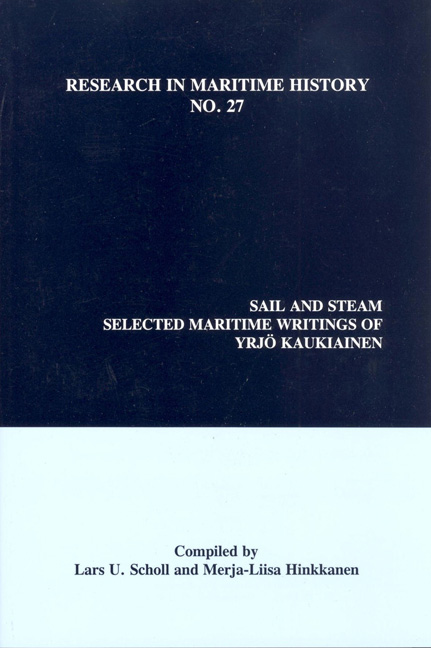Book contents
- Frontmatter
- Frontispiece
- Table of Contents
- Acknowledgements
- “Yrjö Kaukiainen: A Tribute on the Occasion of his Forthcoming Retirement as Professor of Maritime History at the University of Helsinki”
- “Yrjö Kaukiainen: A Man of the Sea”
- “Yrjö Kaukiainen and the Development of Maritime Economic History”
- “Finnish Sailors, 1750-1870”
- “Finnish and International Maritime Labour in the Age of Sail: Was There a Market?”
- “Five Years before the Mast: Observations on the Conditions of Maritime Labour in Finland and Elsewhere”
- “The Maritime Labour Market: Skill and Experience as Factors of Demand and Supply”
- “Owners and Masters: Management and Managerial Skills in the Finnish Ocean-Going Merchant Fleet, c. 1840-1880”
- “From Low-Cost to High-Cost Shipping: Finnish Maritime Labour Costs after the Second World War”
- “The Modernization of Finnish Coastal Shipping and Railway Competition c. 1830-1913”
- “British Timber Imports and Finnish Shipping 1860-1910”
- “Baltic Timber-Trade under Sail: An Example of the Persistence of Old Techniques”
- “Coal and Canvas: Aspects of the Competition between Steam and Sail, c. 1870-1914”
- “Dutch Shipping and the Swedish Navigation Act (1724). A Case Study”
- “Seamen Ashore: Port Visits of Late Nineteenth-Century Finnish Sailors”
- “Wreck-plundering by East Finnish Coastal People - Criminal Tradition or Popular Culture?”
- “From Days and Knots to Pounds and Dollars: Some Problems in the Study of the Economics of Late Nineteenth Century Merchant Shipping”
- “Tons and Tonnages: Ship Measurement and Shipping Statistics, c. 1870-1980”
- “International Freight Markets in the 1830s and 1840s: The Experience of a Major Finnish Shipowner”
- “Shrinking the World: Improvements in the Speed of Information Transmission, c. 1820-1870”
- “Yrjö Kaukiainen: A Maritime Bibliography”
“Baltic Timber-Trade under Sail: An Example of the Persistence of Old Techniques”
- Frontmatter
- Frontispiece
- Table of Contents
- Acknowledgements
- “Yrjö Kaukiainen: A Tribute on the Occasion of his Forthcoming Retirement as Professor of Maritime History at the University of Helsinki”
- “Yrjö Kaukiainen: A Man of the Sea”
- “Yrjö Kaukiainen and the Development of Maritime Economic History”
- “Finnish Sailors, 1750-1870”
- “Finnish and International Maritime Labour in the Age of Sail: Was There a Market?”
- “Five Years before the Mast: Observations on the Conditions of Maritime Labour in Finland and Elsewhere”
- “The Maritime Labour Market: Skill and Experience as Factors of Demand and Supply”
- “Owners and Masters: Management and Managerial Skills in the Finnish Ocean-Going Merchant Fleet, c. 1840-1880”
- “From Low-Cost to High-Cost Shipping: Finnish Maritime Labour Costs after the Second World War”
- “The Modernization of Finnish Coastal Shipping and Railway Competition c. 1830-1913”
- “British Timber Imports and Finnish Shipping 1860-1910”
- “Baltic Timber-Trade under Sail: An Example of the Persistence of Old Techniques”
- “Coal and Canvas: Aspects of the Competition between Steam and Sail, c. 1870-1914”
- “Dutch Shipping and the Swedish Navigation Act (1724). A Case Study”
- “Seamen Ashore: Port Visits of Late Nineteenth-Century Finnish Sailors”
- “Wreck-plundering by East Finnish Coastal People - Criminal Tradition or Popular Culture?”
- “From Days and Knots to Pounds and Dollars: Some Problems in the Study of the Economics of Late Nineteenth Century Merchant Shipping”
- “Tons and Tonnages: Ship Measurement and Shipping Statistics, c. 1870-1980”
- “International Freight Markets in the 1830s and 1840s: The Experience of a Major Finnish Shipowner”
- “Shrinking the World: Improvements in the Speed of Information Transmission, c. 1820-1870”
- “Yrjö Kaukiainen: A Maritime Bibliography”
Summary
For centuries small and medium-sized Finnish sailing vessels transported cargoes of wood and various wood products from the southwestern part of Finland to Mecklenburg, to Schleswig-Holstein and to various Danish ports. The existence of such a trade is not exceptional: Denmark and the German coast west of Rostock lacked sufficient forest resources and had to import increasing amounts of building materials. On the other hand, potential export areas abounded not only in Finland but all over the northern and northeastern Baltic. That trading traditions - at least as far as Finland was concerned - were concentrated in the southwestern areas, the towns of Uusikaupunki (Nystad), Rauma and Pori (Björneborg) and the rural areas of the so-called “Vacka-Finland” (vakka = wooden vessel or basket), were a medieval tradition. It is possible that the early contacts had something to do with the emigration of merchants from the south coast of the Baltic to this area: After settling down, these newcomers, who often turned into hard-core burghers in these small, local towns, retained commercial contacts with their former home areas. Even the mercantile economic system that came afterwards contributed to preserve this tradition: The towns in question were not granted full trading rights before the second quarter of the nineteenth century (in other words, they were not real “staple” towns), nevertheless, they were allowed to trade within the Baltic. Thus, for centuries the interests of the local merchants and shipowners were not diverted from the Baltic trade by any more lucrative prospects beyond the Sound.
However, what is more amazing is the fact that this traditional shipping managed to survive during the revolutionary changes in the shipping world, which took place in the late nineteenth century. Still in the 1920s and 1930s, a score of Finnish sailing vessels earned their living by transporting sawn wood to ports in Denmark and northern Germany, and a couple of wooden three-masted schooners with fore-and-aft rigs were built for this trade even in the late 1940s. These last (auxiliary) sailing vessels did not sail for long on the Baltic and they were strange features indeed in an era with increasingly rapid and regular transport systems - not only by fast motorized ships but also by cars and by plane.
- Type
- Chapter
- Information
- Sail and SteamSelected Maritime Writings of Yrjö Kaukiainen, pp. 101 - 112Publisher: Liverpool University PressPrint publication year: 2004



